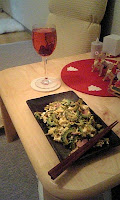
My all time favourite food! This picture was one I took a couple of Christmases ago... Goya champuru is really easy to cook, and goya is a very cheap vegetable in summer. It's just beginning to come down in price to under 200 yen for a large goya now, so I'm starting to eat it more again. In the summer, it's only about 70yen.
Goya is also known as bitter gourd. It's very high in vitamin C. Usually vitamin C is destroyed when you heat it, but with this vegetable it isn't.
Unfortunately, goya/bitter gourd/nigauri is going to be hard to come by in the UK as it needs hot weather to grow, you might be able to find it in a Japanese supermarket...
This is my recipe, I don't use oil or fatty ham in my version... I also use a lot of goya, and it's very filling! It takes about 5 minutes to cook!
Ingredients (serves 1)
1 goya
200g pack firm or extra firm tofu, drained
1-2 teaspoons of soy sauce
60g of parma type ham, or smoked salmon
1 egg
Method
- Halve the goya lengthways and scoop out the seeds with a teaspoon. Slice into 1/2cm semi-circles. Put in a saucepan
- Wrap the tofu in about 3 sheets of kitchen paper and microwave on high for about 2 minutes to drain. Cut into 12 cubes and add to the saucepan.
- Pour the soy sace over the tofu and turn the heat to high. Add the ham or smoked salmon and stir fry until the liquid has just about evaporated.
- Crack in the egg and stir everything thoroughly until the egg has set.
- Best served immediately, although I often cool it and then take it to work for lunch.
Note: Apparently if you put the cut goya in a colander and sprinkle with salt and leave it for 15 minutes before washing, this removes some of the bitterness. I skip this step! In Okinawa and Hawaii, they often use Spam and oil to cook it, which also counters the bitterness. I love the taste of goya and often eat it raw during the summer.







